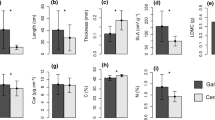Summary
Byttneria aculeata (Sterculiaceae), a subcanopy liane with a shrubby juvenile form has two distinct leaf color morphs in juvenile plants- a given juvenile has plain green leaves or leaves with whitish variegation. Both forms occur together in the forest and in clearings; however, the variegated morph is more common in open sites, and the plain morph predominates in the forest. Percent variegation per leaf for variegated plants increased from closed to open sites. Measurements of growth support the idea that variegation is favored in open habitats. Within a given habitat, rate of herbivory by leaf miners on a given morph increases with increasing relative frequency of that morph; however, at a given relative frequency, the variegated morph is less heavily attacked than is the plain morph when it occurs elsewhere at that same frequency.
Similar content being viewed by others
References
Antonovics J, Levin DA (1980) The ecological and genetic consequences of density-dependent regulation in plants. Ann Rev Ecol Syst 11:411–452
Björkman O, Ludlow M, Morrow P (1972) Photosynthetic performance of two rain forest species in their native habitat and analysis of their gas exchange. Carnegie Inst Wash Yearbook 71:94–112
Cahn MA, Harper JL (1976a) The biology of leaf mark polymorphism in Trifolium repens L. 1. Distribution of phenotypes at a local scale. Hered 37:309–325
Cahn MA, Harper JL (1976b) The biology of leaf mark polymorphism in Trifolium repens L. 2. evidence of selection of leaf marks on white clover by rumen fistulated sheep. Hered 37:327–333
Croat Z (1978) Flora of Barro Colorado Island. Stanford University Press, Stanford, CA
Enos RA (1983) Maintenance of genetic variation in plant populations. Evol Biol 16:129–155
Hedrick P, Gineran M, Ewing E (1976) Genetic polymorphism in heterogeneous environments. Ann Rev Ecol Syst 7:1–32
Kiang YT, Libby WJ (1972) Maintenance of a lethal in a natural population of Mimulus guttatus. Amer Nat 107:351–367
Lee D, Lowry J, Stone B (1979) Abaxial anthocyanin layer in leaves of tropical rainforest plants: enhancer of light capture in deep shade. Biotropica 11:70–77
Leigh EG Jr, Rand AS, Windsor D (eds) (1983) The ecology of a tropical forest. Smithsonian Inst. Press. Washington, D.C.
Morgan MD (1971) Life history and energy relations of Hydrophyllum apendiculatum. Ecol Monogr 41:329–349
Schultz JC, Baldwin IT (1982) Oak leaf quality declines in response to defoliation by Gypsy moth larvae. Science 217:149–151
Smith AP (1977) Albinism in relation to competition in bamboo. Nature 266:527–529
Author information
Authors and Affiliations
Rights and permissions
About this article
Cite this article
Smith, A.P. Ecology of a leaf color polymorphism in a tropical forest species: habitat segregation and herbivory. Oecologia 69, 283–287 (1986). https://doi.org/10.1007/BF00377635
Received:
Issue Date:
DOI: https://doi.org/10.1007/BF00377635




